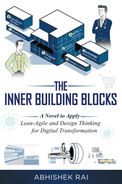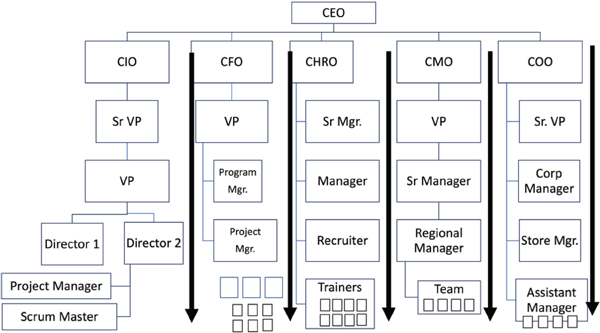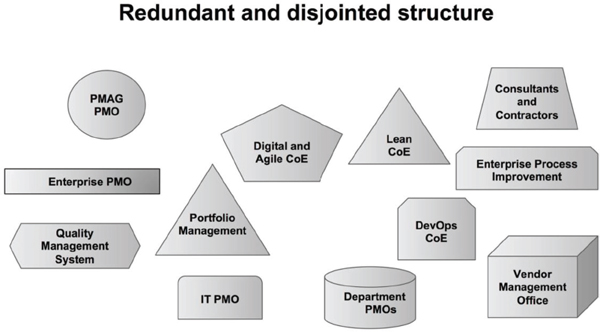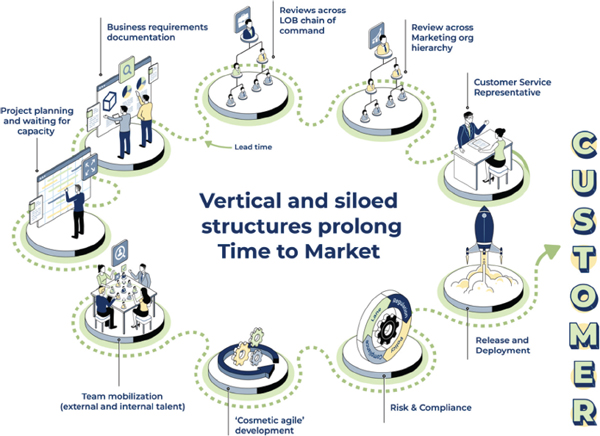Bureaucracy of a Hierarchical ORGANIZATION
Thursday, February 27, 2020
Table 10.1 Kanban board
To-do | In progress | Done |
• Shortcomings in a hierarchical organization • Analyze long Time-to-Market | • Identify common grounds between agile and Doug’s Lean CoE • Resolve funding-related complications |
I am on the dental chair for next 55 minutes with manifold dental tools and fluids inside my mouth … the mirror, sickle probe, suction, syringe, anesthetic, drill, spoon excavator, mold, scaler, and finally polisher cup!
During all this time, the dentist keeps talking to me.
Weird. Does she not realize that I cannot talk with so much metal inside my mouth? It is painful both physically and mentally.
Those 55 minutes are the moments of epiphany. I continue to debate myself. Is this something similar which keeps our employees silent?
How could our people speak their minds when they are stuffed with unyielding HR policies, rigid performance appraisals, conditional bonuses, unbending promotion rules, and risk of getting fired? Their paychecks are directly proportional to overlooking certain things. Our talent cannot freely express themselves and confront their bosses without risking it all.
How can we expect our people to have an obligation to WAR when their survival in the company depends on them not raising problems? They don’t have an adequate psychological support system to freely raise their concerns and solve the problems.
Back to the office on Monday morning.
I see a Kanban board to update on my follow-up on Lean CoE. “You see there has always been a Lean CoE in Walkers even before we embarked on agile transformation. The Lean CoE is headed by Doug Dicky. I am meeting Doug today.” I mention.
Identify Common Grounds Between Agile and Lean CoE
I discuss the dynamics with Sid “Doug had a dotted reporting relationship to Daisy and a direct reporting to her boss, the chief operating officer of the company. You see the reporting relationship defines what you can and cannot do in this company. It is the political minefield you see!”
I tried to raise it to Richie a few times, but he couldn’t do anything as it’s outside his territory. I continue. “Doug’s team implements lean-driven business process improvements in the supply chain, fulfillment, logistics, and store operations. People in business and operations think lean is theirs and people in digital think agile is ours.” I say with a feeling of helplessness.
“I know Doug thinks of me as someone who is coming from the agile camp and competing to land grab his Lean CoE. He thinks I’m his rival. Despite having tried to reach out to him to collaborate on a few projects on a number of occasions, I’ve lost count.”
Sid jumps in, “Unfortunately, this is common for most companies. One of the side effects of traditional organizational structures is spawning distinct cultures, mindsets, and opposing interests. Like children we want to play with our own toys and sometimes we are not so good in sharing each other’s toys.”
“Why don’t you have a heart-to-heart with Daisy to get her support? Tell her how critical it is for timely digital releases to have joint firepower of lean and agile.” He sips his smoothie rather brashly.
I write to Doug and copy in Daisy and Richie clearly to up the ante.
Daisy responds with a one liner, affirming my approach.
“Neil, Great effort. Thanks.”
Doug and I plan a working session to resolve the long running stalemate.
Figure 10.1 WALL No. 14
Table 10.2 The Writing on the WALL No. 14
14. Rift between agile and nonagile factions | |
What does it mean? | • The chasm between two conflicting ways of working (agile and traditional project management) causes discords and rivalry • The role of agile practitioners’ conflicts and clashes with traditional roles like project and program managers |
What are its effects? | • Creates friction, frustration, and confusion in the workforce • Unproductive conversations and adverse impact on customer centricity |
He accepts my invite, and we meet later in the day on his side of building.
Doug starts with a combative tone “Daisy wants me to almost shut down lean CoE. I have half a dozen lean consultants and coaches. We all cannot just become part of agile CoE. And so, whose fault is this?”
“But guys let’s be clear what we are trying to do here? And what do you want from me?” Doug removes his spectacles.
“We have a toxic culture of old and new fighting with each other. Our groups constantly lock horns.” I sound like a broken record.
Sid quickly interrupts. “Guys, could we first clarify a few things on lean and agile methods?”
We both nod vigorously.
Figure 10.2 E-mail—unified lean–agile
“What we know as agile today is built in the last two decades, and I believe agile has some clear roots that we can relate to lean thinking. Agile started in IT/software and is now being imagined enterprise-wide, while lean principles can be applied virtually anywhere, though they could trace their roots in automobile manufacturing context like Toyota production system (TPS).
So, in a way, we could think of lean thinking as a genesis of agile!” Sid suggests.
Doug looks happier and suddenly his eyes brighten up. “I love it. You mean it? Right?”
“I believe they are extremely complimentary and symbiotic, and a meaningful combination is the best way forward!” Sid adds.
“Lately, most of the leading industry frameworks emphasize both lean and agile as two important foundational pillars of agility across the enterprise. Agile is an umbrella term which may refer to scrum, Kanban, XP, and lean software development.” I suddenly realize I am back to defending my own terror-tory.
“We do not have to restrict ourselves to one method or standard, but we can borrow other frameworks and methodologies with an eye on business outcomes and customer experience. Zen design for exceptional experiences lean to cut wastes and agile sprints to orchestrate and integrate methods.” Sid proposes.
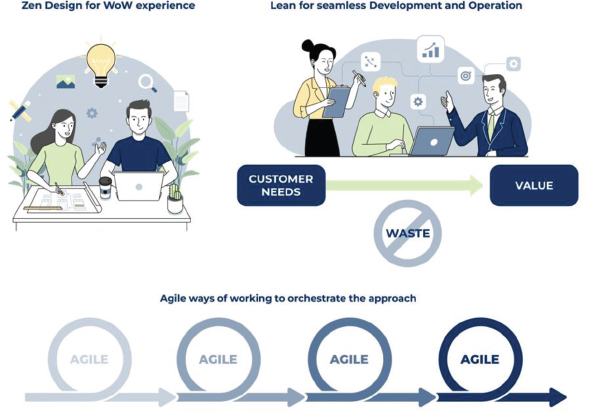
Figure 10.3 Lean, agile, and Zen
“So, what’s our goal here?” Doug asks.
“It has to be to advance the overall, holistic, and end-to-end agility.” I am careful to say agility and not agile.
“The focus needs to be on No Regret moves, anyone could do them. These are universally accepted best practices from lean and agile and you can’t get it wrong.”
Finally, Doug looks to be on board.
“The most basic thing that you could do to applaud and appreciate your teams?” Sid asks, bringing his two hands together.
“You clap?” Doug responds.
“Precisely, that is what we could plan to do to appreciate, endorse, cheer, and energize our teams with this minimum common guidance.”
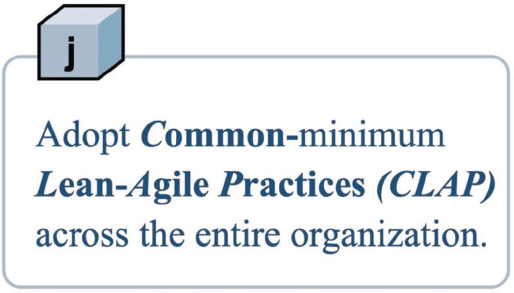
Figure 10.4 BB j
The CLAP is a modest yet a powerful symbol for everyone about the feeling comfortable, excited, and being welcomed—the psychological safety for teams to adopt common-sensical practices. Finally, we all agree on something.
(j) CLAP—Common-minimum Lean–Agile Practices
Adopt elementary lean–agile values, principles, mindset, and common-sensical practices for all teams including those not deliberately practicing agile. Establish mechanisms and forums for regular engagement and collaboration between agile and “nonagile” groups.
Clarity of purpose:
• Any one live lightweight document which is adaptable like OKRs (Objective and Key Results), a product roadmap and mission statement, and a roadmap.
• OKRs include an objective which is a clearly defined goal and set of three to five key results which are measurable.
Timebox with cadence:
• Sprint and release—both are not same.
• Sprint is a timebox of two weeks to complete a sprint backlog. (Sprint backlog is the collection of stories/tasks for a sprint.)
• Release refers to epic or a group of features from product backlog made available for customer. (Product backlog comprises of the epics and stories for a cluster of sprints.)
• Invite nonagile or traditional teams in all key lean and agile events.
Communication flow:
• Fifteen to twenty minutes stand-ups or huddles to collaborate, sync-up, identify blockers/impediments, re-energize, and plan subsequent conversations (This is not a status reporting.).
• Accomplishments/outcomes further to the last stand-up
• Blockers, if any, impeding the progress
• Customer-centric story, tasks, or conversations planned
Visual management with Kanban:
• Three columns of “To-do,” “In progress,” and “Done” to visualize work.
• Set a work-in-progress (WIP) limit so that there is a maximum of three items “In progress” column per person.
Prioritization: (a) A simple MoSCoW classification
• Must have: Must have are critical requirements to the current release and sprints.
• Should have: Should have are quite important but not essential for delivery timebox.
• Could have: Could have are desirable and “good to have” but not necessary.
• Won’t have (immediately): Won’t have are least critical and are not for immediate considerations but could be reconsidered and refined at a later point in time.
Retrospective: Looking back at events so we identify what went well, what didn’t go so well, and what actions we could take to actionize our learnings.
Continuous improvement:
• Relentless obligation toward Waste Avoidance and Removal (WAR).
• Kaizen and A3 Thinking for focused and structured improvements.
• A3 is the crisp and concise visual manifestation all in one view of A3 or similar size paper.
• Kaizen is about small improvements at regular periods which lead to sustainable improvements and outcomes eventually.
Shortcomings in a Hierarchical Organization
We decide to map the organization and see how we could navigate the organization.
During value stream mapping, we had a chance to observe how each of our product departments are run by a VP with a dotted or sometimes solid lines reporting relationship to Daisy.
The organization structure complexities are compounded due to several other permutations and combinations in our reporting structures. Three VPs have direct reporting to Daisy, while two of them also had dotted reporting to Richie for some reason. All of them had direct reporting or in some cases reporting dotted to Charlie our CEO. Two of them have reporting to our head of Fulfillment and one to our head of Merchandising. It was a maze, a perfect tangle, and a constraint!
We are left in this labyrinth to navigate the intricacies of Walkers’ cryptic organizational structure. No one moves across teams even when it made a lot of sense without a “go ahead” from their three to four bosses who are too busy fighting their own battles!
Each VP had nine more levels of employees within each of the product category departments (PCDs) like grocery, household, home, furniture and décor, fashion apparels, shoes, and so on.
There are four layers of product management that must approve, before I can approve for release. In cases where the GRC team has raised risk and compliance issues, it requires further approval from the CIO, Richie himself.
Sid shares a few perspectives on redesigning our company.
“Our structure is vertical with reporting managers defining the work. Lean–agile as a philosophy is ideally to imbibe a coach’s mindset and not a traditional manager, so reporting line should not be a primary concern and never the starting point. The focus should be more on agile broadly to reduce too much hierarchy, loosening formal reporting structures and easing the command–control style of working.”
Figure 10.5 Vertical organization
“Too much emphasis on reporting could also mean teams may have to dilute their independent thought, creativity, and fearlessness to challenge their reporting managers to change status quo. However, most organizations still need to have a line of reporting, and there may be nothing wrong as long as it’s constructive. Agile and lean are all about reducing solid line reporting, eliminating too much hierarchy, and easing the command–control style of working.”
After my meeting, I can hear Hana calling me from the far end of the corridor as I walk to the colored printer across the WALL area.
Hana Saito, the head of governance, risk, and compliance, is highly risk averse and resists anything nimble and agile!
“Hey Hana. How is it going?” I ask.
“Am I the one in trouble again?” I say jestingly.
This is a joke that we share whenever someone from Hana’s GRC team makes a guest appearance. They always ask us to delay a release, fill some form, or ask us to submit long compliance documentations.
Hana is not so fond of the joke. She disregards it with sarcasm and a forced smile.
“Hey Neil, I heard that you are reaching out to all those smaller vendors who are not in our approved list. I do not like the way we have started contacting the external vendors and bypassing my team.”
I confront her immediately. “I did communicate but did not sign any SoW. But anyways how does this concern you? You don’t control the vendor conversations, do you? You are GRC, Governance, Risk, and Compliance.”
She nods and folds her arms.
“Indeed, we are GRC for vendor standpoint too as there is no OSAP at all. We used to advise them on all vendor risks as well. And when you keep us out of the loop, you are triggering a major risk. It’s a reputational risk and we have internal control, forms, templates, checklists, and policy documentation you need to comply with, get approval before we approve such vendor meetings.”
“You should know that by now.” She says with a hint of disappointment.
Are you kidding me? We don’t even know if Walkers will still exist in the next few months and this person is reminding me of some archaic rules, checklists, and forms? God save us!
I feel the need to scream but I restrain myself.
As she continues with some other internal controls that I have never heard about, I wonder if she is part to blame for some of our rapidly growing issues and delays. She is really getting on my nerves!
“Let’s address this situation without getting upset.” I calm her down and continue,
“Hana, listen I don’t need to lecture you, but we need timely and transparent exchange of information with vendors. We need regular dialog with vendor folks at the frontlines. For us to be truly agile, all communications internal and external need to be unambiguous and timely to encourage participation and timeboxed actions. I need your help on this.”
She does not like my discourse, but does not to argue further.
I suggest meeting her later. She agrees with some reluctance.
To prepare for our meeting I explain to Sid the structural problems at Walkers.
Analyze Long Time-to-Market
“The manifold and even redundant departments, PMOs, CoE end up becoming silos, so the value stream construct helps to align the horizontal to the vertical by placing stress on the horizontal flow of value to consumers and reducing the red tape and bureaucracy which cause delays and inefficiencies.”
The organizations are organized vertically, while the value flows horizontally.
“Traditionally, top management has always preferred for Walkers to have a structure which has multiple layers of managers and supervisors to manage and most of the time micromanage our teams. Decision making is rarely delegated. There are many vertical mini-hierarchies within the large hierarchy.” I complain.
“As we see they don’t fit in with each other. We have all these different functions for each department organized vertically with their respective measures while the value is flowing horizontally to the customer. Therefore, the organization always believes in multiyear product roadmaps and budgets.” Sid extends his understanding.
Figure 10.6 Redundant and fragmented groups
“The departments slow down and throttle the pace of decision making and implementation of actions due to the vertical focus of each department official reporting to the head of the department, and not across the horizontal value chain where the customer is consuming the value.” He explains.
The departments are organized vertically while the flow of value is horizontal which creates communication gaps and friction as teams report to the head of functional department, and not to the customer—who are at the end of the value chain. The different units and teams have a manager or supervisor and the team rolls up to this individual, while the customer is at the end of the value stream. They do not care about the internal organizational setup of the companies. The organization always believes in multiyear product roadmaps and budgets.
Teams are organized by their specialties which in turn creates silos. Organizations become a collection of vertically organized silos each led by different managers. Managers start to fight turf wars and largely focus on their internal territorial battles more than worrying about customer experience and actual customer problems. Although the intentions initially come from a good place, most of their efforts are quickly undone.
I am taking down notes, as Sid sheds some light on our very present issues.
“Let’s look at our organization right from the time a customer need arises. So, it’s then analyzed, and documentation is provided to the product team, and then the solution is bland belt testing released back to the customer needs. How many departments or groups do you think are involved here?”
Table 10.3 The Writing on the WALL No. 15
15. Communication gaps due to silos and layers | |
What does it mean? | • The territorial silos and structural complexities in companies create newer barriers and challenges in regular and seamless internal communications • Office politics, lack of psychological safety, and vested interests weaken one of the foundations of agility—transparent and timely communication |
What are its effects? | • Hidden factories erode trust and prolong the schedules • Unpleasant surprises lead to unstable products and solutions |
Figure 10.7 Longer Time-to-Market
“I see each group creates an additional loop of reviews and decision making which prolongs the entire process. This is unacceptable.
The conception of horizontal organization is far better for a continual enterprise which persistently provides business value to the customer.” I concur.
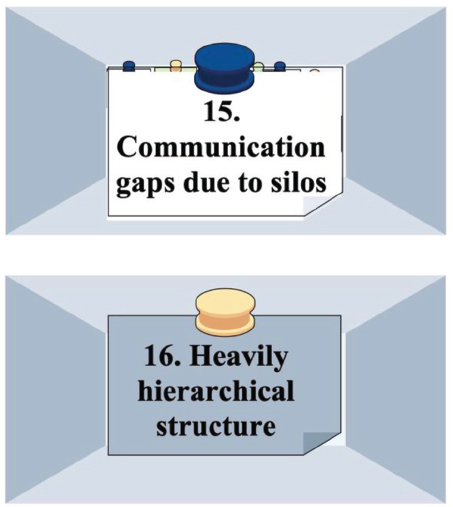
Figure 10.8 WALL No. 15 and 16
Table 10.4 The Writing on the WALL No. 16
16. Heavily hierarchical structure | |
What does it mean? | • Disproportionate centralization and multiple layers of bureaucracy slow down communication, lower collaboration, and waste valuable resources • Decisions making becomes very slow due to review and approval required across the manifold echelons of the company |
What are its effects? | • Hidden factories diminish trust and increase Time-to-Market • Bureaucracy, red tape, and inefficiencies lower engagement and productivity |
Resolve Funding-Related Complications
I slowly approach Tim’s office. I have not been in there for a while, as Tim’s office always overwhelms me.
He has an old-fashioned office, with wooden and antique pieces. The only modern items, as far as I am aware, are monitors, the printer, and the two projectors. His office is always full of paperwork, whether it is at his desk, by the trash can, or scattered across the table. I don’t remember the last time I was in there when there were no files, folders, or pieces of office stationery piling up on his desk. The clutter is a precise reflection of the underlying issues.
“Good morning Neil.” Tim sees me walking to his office.
“Hey Tim, how are you this morning?” I smile, lightening the mood.
“Well, you know the drill, Richie wants the funding, project budget reports, and our guys don’t do their work properly so as usual I am drafting nasty e-mails!” He sounds condescending, this is typical of Tim.
“So, what’s up, you wanted to talk?”
Tim continues to look at his laptop, talking to me as if he has more important things to do.
“I wanted to talk about something important.”
He is busy in his e-mail. He doesn’t look at my eyes, he just nods.
After almost a minute, I give up waiting and continue.
“It’s no secret what kind of mess we are in! We all know Walkers is going through a real rough patch, and with this virus, I’ve been tasked to expedite digital projects. I’ve been told everything is on the table. One of the ideas that I’m in the final stages of discussions with Paris is new funding model, and it also impacts compensation.
So, we need to align the cadence of people compensations with the business value.”
As soon as Tim hears funding, compensation, and costs, he stops typing, thinks for a few seconds, and looks straight at me.
“Neil.” He almost raises his voice.
“What does that even mean? Take a pay cut or you don’t get paid if you are on a long-term project?” He inquires.
“Everyone who is a part of the teams delivering continuous value continues to get pay checks every other week as per our C&B, the compensation and benefits policy. For those in teams which are not able to show business value their teams are producing, they could see a shift toward a quarterly frequency of pay checks.” I try to make something up.
“All those colleagues in product development who are part of teams in IT and digital would be measured based on the frequency of releasing business value to one of the four deployment environments. This needs to be for the customer, and if its an internal project, it needs to be aligned to one of the Walker OKRs.” I share an example.
“So, you could be working on anything ranging from an app for a customer, enhanced experience design, a new product enhancement, an upgrade in architecture, customer services, or also something which is internal but has a strategic component associated to our OKRs, you know!” I ramble somewhat.
“So, if a project is supposed to last five months and deliverables are due only at the end of the project, then perhaps release may happen even later, and the folks don’t get paid?” He asks in pure disbelief.
“They get paid for sure, but later at the end of quarterly milestone when we can see the value that they have produced.” I try to sound believable.
He stresses on “deliverables” and I continue to emphasize the “value”.
“Is it even legally allowed? Did you check with Hana? I don’t think it will work.” He refuses.
I try to make up something in my head fast. I am pulling a bluff, but it is my only way of winning Tim over to my side. I chose my words carefully without mentioning any other name.
“I have deliberations in progress so we could make this decision quickly.” I continue to bluff.
“So, if I have a set of projects which are not releasing value for the customer or any internal user I don’t get paid?” I nod with a serious look on my face.
“We don’t need to deliver value and make releases every other week. I think that we should still get paid, we want to get paid!”
“Hey, Tim.” I try to explain him.
“Is this even fair to those who are working in an agile way with faster cycles and those who don’t have the luxury of spending time on internal stuff to make long reports?”
He sighs.
“They need to act fast for the needs of our customers. Don’t they have to?”
“When we expect to be paid every other week, why can’t we build something of real value with the same cadence?” I ask him.
I take his silence as an “I gotcha” moment.
Tim realizes there is no point continuing the argument. “Some of our projects are already in agile mode. For those which are not, I will focus more on faster delivery and at least one of the business values you mentioned?”
As I leave, I make it a point to look him in the eye. He has wasted last year creating all the resistance.
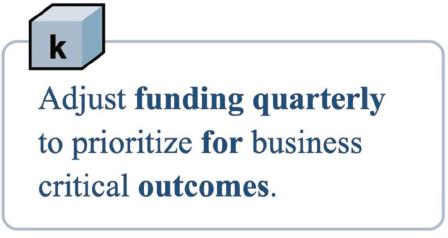
Figure 10.9 BB k
(k) Funding for quarterly outcomes
Table 10.5 Outcome-based funding
Later in the day Sid and I go to the corner meeting room. Hana is sitting silently making notes on her writing pad. She has a bunch of papers, neatly arranged in their red, yellow, and blue colored folders.
As I knock, Hana pauses for a few seconds to look at us and goes back to her paperwork.
Hana was in meetings for the entire day given her involvement and in a wide variety of legal and compliance topics. Their team’s explicit approval is needed on almost everything. And no one in her team dares to approve requests without a review meeting with her.
“Hana, do you mind helping us understand what your group does? So far, we understand that the GRC group includes risk management, compliance, legal, control audits, and governance, is that right?” I respectfully ask her to define specific responsibilities of GRC to reveal their overreach in interfering in almost every area.
Compliance to Internal Controls, Policies, Procedures, or Guidelines
• Compliance to external or government-defined regulatory framework and policies
• Risks management which preempts and the potential failure modes or deviations from the desired results and expected outcomes
• Legal group which primarily focuses on legal implications, data privacy, data breach, and guidelines on complying with legal framework
Sid says “Invariably, the control functions tend to be overzealous and extra-cautious. This is not a bad thing in itself; however, this could substantially reduce the speed, agility, and efficiency of the solution development and timely movement of value to customers. It’s a genuine obstruction to agility, when combined with the one of the following scenarios:
• Lack of clearly defined accountability and responsibility with the control functions
• Overlapping and redundant guidelines provided by control functions
• Only one or two decision makers in upper echelons for workarounds or exceptions
• Lack of assigned compliance and GRC SMEs to the agile teams”
Hana looks offended and spreads her arms.
“My team focuses on the regulatory requirements to protect our customers. For instance, there are many apps in our phones which could track our locations and communication without us knowing. This is a blatant invasion of our privacy and needs regulatory policies to be constantly reviewed and enforced for preventing this.” Hana explains her case.
“There are a multiple interpretations and implications which need to be studied and examined for the implementation. What we receive from the legal and regulatory compliance standpoint is ‘what’ and not ‘how’ the practices need to be governed. This means we are always asked to ensure compliance without clearly defining the ‘how’!” She expounds.
I jump in,
“Yes, absolutely we all need to help in the privacy protection. But this opens the GRC to a much wider interpretation and micromanagement. Tight command and control by any function suffocates innovation and downgrades agility. GRC needs to be engaged and stay collaborative in the boarder lean–agile transformation. They definitely could bring more focus on oversight but keep it pragmatic.
In a nutshell, the GRC needs to continue setting higher bars for themselves by proactively defining specific, actionable, and easy to understand compliance requirements.”
Sid wants to get tactical: “Perhaps, let’s have some rules?”
Lightweight Rules of GRC Engagement
• GRC to build A3 size sheet to provide unambiguous guidelines without expecting follow-ups by the agile teams.
• The agile team including the product owner, scrum master, and data architect should provide a clearly defined intent of the solution.
• Assign right GRC SMEs, subject matter experts in part-time capacity to agile.
• The GRC SMEs must be clearly explained the intent and the key components of the solution, the data flow architecture, potential data privacy, and other risks.
• The GRC team members:
![]() Spend two half days in a sprint with the team.
Spend two half days in a sprint with the team.
![]() Join at least two stand ups in a week with teams.
Join at least two stand ups in a week with teams.
![]() Attends the demo/sprint review sessions of the digital teams.
Attends the demo/sprint review sessions of the digital teams.
![]() The guidance is added to the acceptance criteria and ensure definition of done does not compromise compliance and stability.
The guidance is added to the acceptance criteria and ensure definition of done does not compromise compliance and stability.
I return home late in the evening after a long day at the office. I find myself drowned in worrying headlines and coronavirus updates on the local news, with the rate of virus infections in the town on the rise. There is a Governor’s live press conference.
“Dad is watching the news again mom!” Tina reports me to Cindy. Ami and Tina could hear the TV echoing from upstairs.
Lately, the girls have been noticing how anxious and worried I get when I watch the news. The rate of infections and deaths related to COVID-19 in neighboring states where our extended family live have me worried about Cindy, as the risk of her catching the virus is high during her chemotherapy sessions.
I stop myself from getting lost in my worries and thoughts, and head upstairs, where Cindy and the girls are snuggled up eating pizza and watching a movie. Instead of worrying, I join them and spend the rest of the evening with my family. “What a welcome diversion elevating all our moods!” I exclaim.
Table 10.6 Kanban board
To-do | In progress | Done | |
• The hierarchical organizations are organized top-down vertically, while the value flows horizontally for the customer • Clarity in roles of GRC in internal controls and regulatory compliance • Lightweight rules for systematic GRC engagement | |||
The latest Writings on the WALL: 14. Rift between agile and nonagile factions 15. Communication gaps due to silos 16. Heavily hierarchical structure | The latest Building Blocks: j) CLAP—Common-minimum Lean–Agile Practices k) Funding for quarterly outcomes | ||
